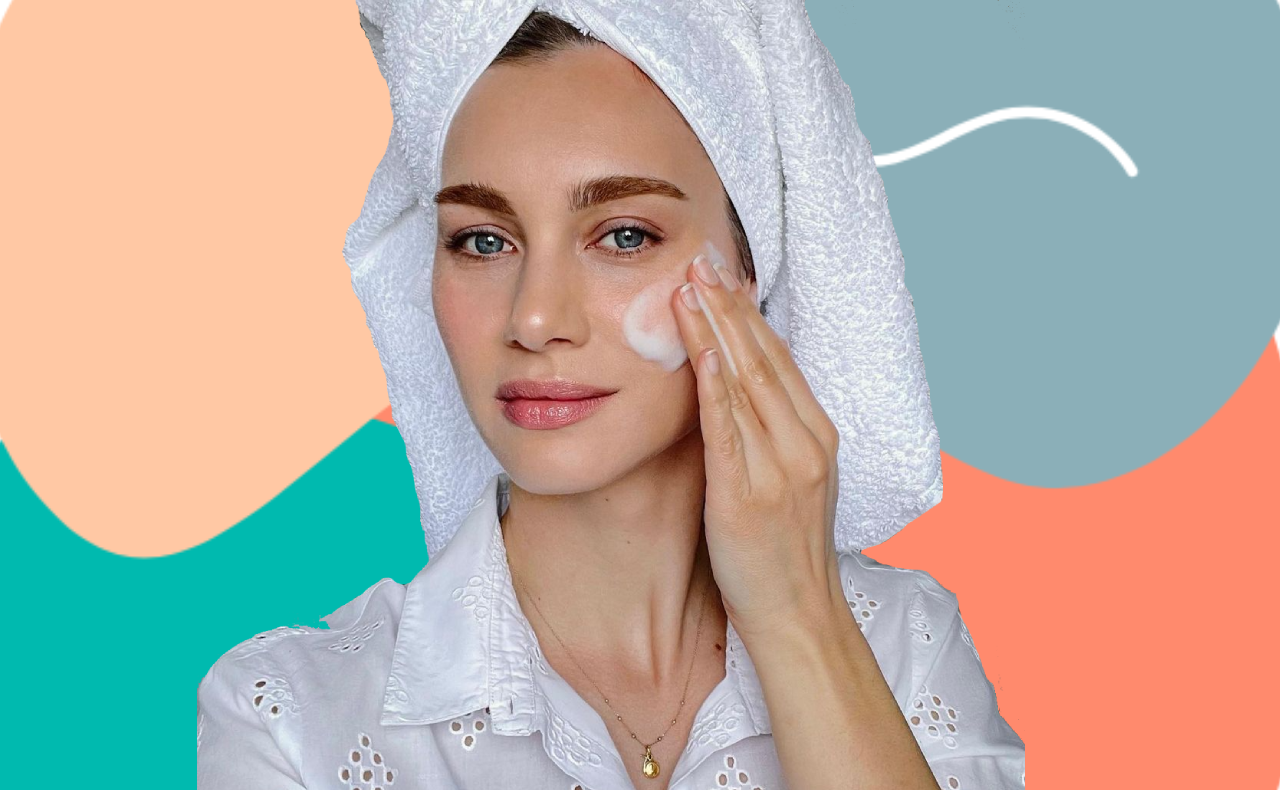As far as anti-ageing skincare ingredients go, it doesn’t get much more talked-about—or misunderstood—than retinol.
RELATED: Everything you need to know about vitamin C
RELATED: 7 best sunscreens for sensitive skin
To name but a few of its many benefits: retinol (a form of vitamin A) is well-regarded for its ability to reduce the appearance of fine lines, minimise pigmentation, enhance collagen production and even reverse some signs of sun damage.But for all its known advantages, retinoids (the umbrella term for retinol products) come with as many—if not more—misconceptions that confuse even the most ardent skincare enthusiast.
And to help break down these longstanding myths and clarify the confusion surrounding retinol, we consulted Dr. Michele Squire, a PhD-qualified skincare scientist and founder of personalised skincare consultancy QR8, to separate fact from fiction.
Scroll on for nine major retinol myths and the expert-approved answers you need to know.
1. RETINOL AND RETINOIC ACID DO EXACTLY THE SAME THING
Generally speaking, yes—both products aim to provide the same benefits, but it’s not quite that simple.While ‘retinoic acid’ is found in prescription-only formulas that directly penetrate the skin and bind to cell receptors to target visible ageing, ‘retinol’ is a weaker derivative of vitamin A that is available off-the-shelf, which the skin needs to convert into retinoic acid at the cellular level for it to affect the skin.
“Retinoic acid can penetrate skin and directly bind and activate retinoid receptors in cells to exert its effects on skin,” Dr. Squire explained.
“Retinoic acid (most commonly tretinoin) has decades of safety and efficacy results in clinical studies, and is considered the gold standard topical treatment to improve sun damage and ageing skin concerns. It is a ‘therapeutic’ (medicine), not a ‘cosmetic’ and is only available with a doctor’s prescription.”
2. RETINOL SHOULD NOT BE USED AROUND THE EYE AREA
Let’s banish this myth once and for all: yes, you can use retinol around the eyes (but you should do a patch test first).“Skin around the eyes is often one of the first places to show signs of ageing and sun damage, so careful use of vitamin A around the eyes is a good idea,” Dr. Squire told us.
“However, you need to patch test first, and never apply it closer to the eye than the orbital bone.”
3. RETINOL SHOULD NEVER BE WORN DURING THE DAY AS IT INCREASES YOUR RISK OF SUNBURN
This is easily one of the biggest myths when it comes to retinol, but there is some reasoning behind this misconception. As it turns out, it’s less to do with your skin, and more to do with reducing the efficacy of the product.“Yes, it is a myth! The reason why retinol and retinoic acid shouldn’t be used during the day is because they degrade in sunlight. The safest thing to do is just use your vitamin A product at night,” said Dr. Squire.
“When starting vitamin A, particularly the prescription retinoids, your skin can be more sun sensitive during the initial adjustment period (called ‘retinisation’). But after this, around the 3-month mark, it reverts to normal.”
4. RETINOL THINS THE SKIN AND THIS IS A BAD THING
Yes and no. Vitamin A (particular in retionic acid form) affects the various layers of the skin differently, and at different times during treatment.“Within the first weeks of treatment, the outermost layer of the skin becomes more compact (which could be termed ‘thinning’), but this actually improves skin smoothness and glow,” Dr. Squire explained.
“Over several months of treatment, the epidermis reverts to its normal state, but in the deeper dermis, collagen and glycosaminoglycan (a group of complex proteins) production increase, which plumps out lines and wrinkles, minimising their appearance.
So the dermis actually ‘thickens!'”
This myth is likely a result of the ‘retinisation’ reaction that can happen in the skin when people first start using vitamin A (especially the prescription-only variety), particularly in conjunction with a skincare routine that already includes physical and chemical exfoliants, lots of product layering and other active ingredients.
“There is often (not always!) an adjustment period where skin is drier and prone to flaking and irritation. People often explain this to me as ‘thin’ skin,” said Dr. Squire.
“For this reason, I always recommend a simple routine consisting of a gentle cleanser, moisturiser and high-SPF sunscreen when starting out on a vitamin A product.”
5. RETINOL DELIVERS RESULTS WITHIN A MONTH
“The results of vitamin A treatment are dose-dependent, so this will depend entirely on the formulation of an over-the-counter (OTC) retinol, and how often you apply it,” said Dr. Squire.“As explained above, many people notice early results with tretinoin (retinoic acid), but this also depends on how often you apply it, and how you manage the retinisation period.”
6. RETINOL MUST BE APPLIED TO DRY SKIN
Despite the prevalence of this myth, when it comes to putting vitamin A products on wet or dry skin, it ultimately boils down to what works for you.“The theory here is that applying vitamin A to damp skin allows greater absorption, and therefore greater irritation. But most people will experience at least some retinisation irritation even when applying vitamin A to completely dry skin!” Dr Squire told us.
“There are no head-to-head studies comparing application to wet or dry skin and resulting irritation, so my advice is to do what works for you. It isn’t always feasible to sit around for 20 to 30 minutes waiting for your skin to dry before applying skincare.”
7. RETINOL WILL MAKE YOUR SKIN PEEL
“Not necessarily. No one really knows why the retinisation reaction occurs, but you can still get results with prescription vitamin A, even without peeling,” Dr. Squire noted.“OTC retinols are a little more tricky—a lack of peeling may relate to the formulation or dose of your product. If you are using an OTC retinol for months on end, and not noticing any difference to your skin, it might be time to upgrade to a prescription product.
“Moreover, OTC retinols typically don’t induce a significant peeling period, so if you have uncomfortable redness, itching, irritation, peeling and dryness, it could also be a contact irritant reaction to your OTC product!”
8. RETINOL SHOULD NEVER BE COMBINED WITH VITAMIN C
Because there are so many different types of vitamin C products on the market, and they all work within different pH ranges, it’s hard to generalise with this one.While they can work together within the same skincare routine, Dr. Squire advised against using them at the exact same time.
“Vitamin A and vitamin C do work synergistically in the same routine to reduce signs of sun damage and ageing skin, but to be safe, use vitamin C in the morning and vitamin A at night,” she said.
9. RETINOL SHOULDN’T BE IN A SKINCARE ROUTINE THAT ALREADY HAS OTHER ANTI-AGEING ACTIVES
In the long run, this misconception does not really apply, however when you are starting out with retinol or retinoic acid, it’s good practice to simplify your existing skincare routine to minimise retinisation.“Over time, you can phase other actives like vitamin C and AHA/BHA back in, but do it slowly and carefully, patch testing as you go,” said Dr. Squire.
Words by Sukriti Wahi
Main image credit: Getty





Love retinol. Wish retinoic acid was available without going to the doc. Around the eyes-a must. This is where I put my retinol and 14% AHA first. Drenching the area.
Great information on Retinol. It’s good to know before using it.
Yes it’s great for preventing the aging as the anti aging substance…
Retinol is great stuff – it works noticeably! I have to apply it when my skin is dry; otherwise, it seems to sit on my skin for ages.
Good to know that it’s a night time product only
Interesting information in this article, it’s good to know more about Retinol.
I love retinol products and use them every day. Thanks for the informative article.
Interesting information, thank you 🙂
Lots of information! Glad to have read it.
Greatt o know
I keep on forgetting that Retinol shouldn’t mix with Vitamin C. Luckily this post refreshes my memory. A good read.
Great info… Thank you for sharing…
Reading this article has reminded me to start using my Vitamin C serum again in the mornings. Since starting the Olay Regenerist Retinol 24 Night Moisturiser, I had been skipping the morning Vitamin C serum step.
Good to know and remember.
Thanks for the information
Thank you for sharing this great information.
A helpful article, thanks BH
Great in depth article
Didn’t know you can’t mix retinol with vitamin C .Very interesting article.
I feel so lucky that I have a prescription to Tretonion if that is how you spell it.
Is tretinoin the same as retinol?
It’s different, here’s some more info that I just copied from another site…
Tretinoin is a medication used to treat acne and sun-damaged skin. It can’t erase deep wrinkles, but it can help improve the appearance of surface wrinkles, fine lines, and darks spots.
Tretinoin is also known as retinoic acid. It’s the generic name for synthetic vitamin A. I
I use Tret!
Thanks Rinny! That’s great to know. Much appreciated.
No worries, my dermatologist recommended I get a prescription from my GP for it as I sometimes form hard lumps (milia) on my face that she burns off. I still get the milia but maybe not as often as before.
Great info. I’ve just started using retinol so the info is appreciated
Thanks for this article!
This article was great for me as I learned something I didnt know. I use a prescription retinoid and I did know about ther skinlikely to be more sun sensitive However I didnt realise that this was only during the initial adjustment period (called ‘retinisation’). and after this, around the 3-month mark, it reverts to normal.”
Wow! Very interesting! Thank you!
I always use a titrated retinoid around my eye area!
Informative article!
I am getting the peeling and redness. It sucks. My skin was done beforehand.